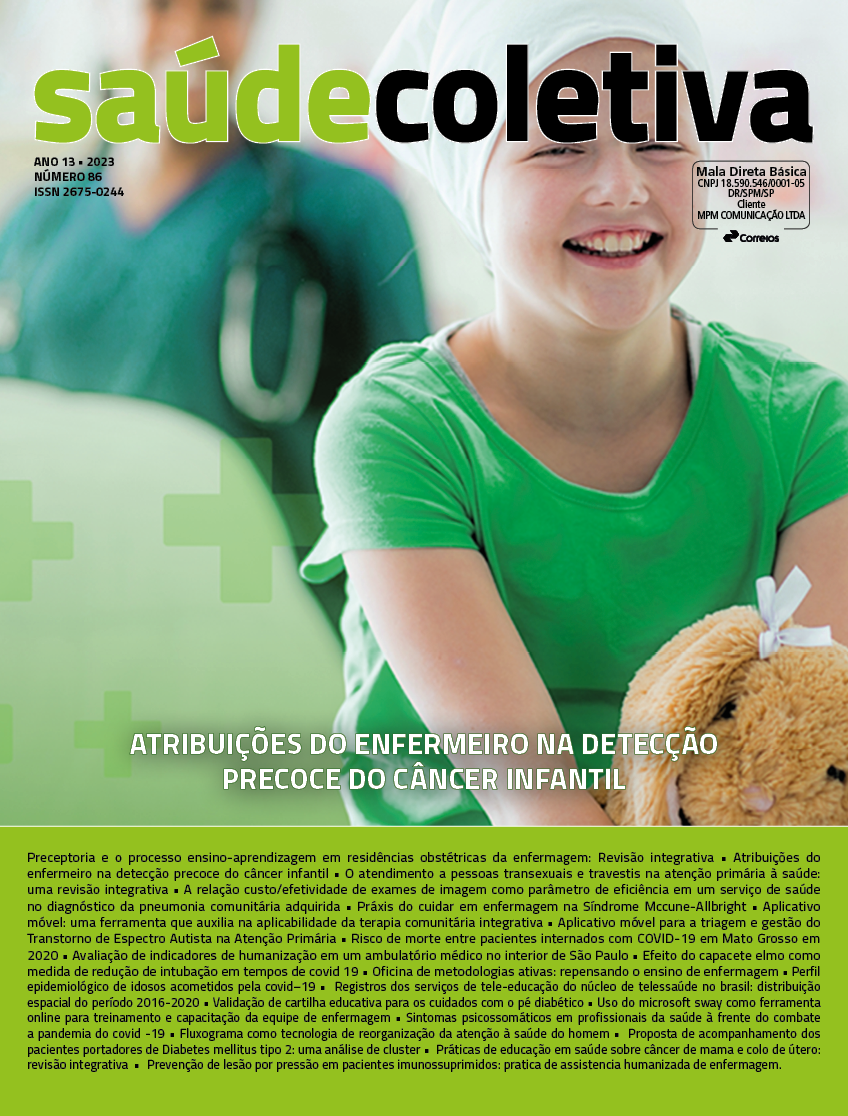EFEITO DO CAPACETE ELMO COMO MEDIDA DE REDUÇÃO DE INTUBAÇÃO EM TEMPOS DE COVID 19
DOI:
https://doi.org/10.36489/saudecoletiva.2023v13i86p12647-12662Palavras-chave:
Pneumonia, SARS-CoV-2, COVID-19Resumo
Avaliar os efeitos do capacete ELMO como medida de redução da necessidade de intubação em pacientes hospitalizados com COVID-19. Trata-se de uma pesquisa de caráter prospectivo, quantitativo e descritivo com uma amostragem. A coleta de dados ocorreu entre maio e junho de 2021, com 28 pacientes com COVID-19 e divididos em dois grupos: Grupo Tratamento Convencional e Grupo Capacete ELMOcpap. Quanto a intubação, 10 (30%) foram intubados após sessão ELMOcpap, o SOFA foi de 243 (7,4%), e 6 (18%) evoluíram à óbito. Para pacientes entubados, 46% foram evidenciados no GCE e 30% no GTC. Ainda, quanto ao desfecho 32% do GCE e 6% do GTC evoluíram para óbito. Diante deste contexto, constata-se que o Elmocpap não se mostrou vantajoso em relação ao tratamento convencional; e, o aumento das pequenas sessões de fisioterapia respiratória indica uma melhora na evolução clínica da doença.
Referências
Borges, Daniel Lago, et al. "Posição prona no tratamento da insuficiência respiratória aguda na COVID-19." Assobrafir Ciência 11.Suplemento 1 (2020): 111-120.
Barauna, Luiz Henrique, and Fleury Ferreira Neto. "Uso da ventilação não invasiva na SDRA e pneumonia secundária a H1N1: revisão sistemática." Revista Pesquisa em Fisioterapia 9.3 (2019): 396-408.
Ferreira, Susana, et al. "Ventilação não invasiva." Revista Portuguesa de Pneumologia 15.4 (2009): 655-667.
Pinto, Ana Rita, et al. "Ventilação mecânica não invasiva e a severidade na disfunção temporomandibular em portadores de doença pulmonar obstrutiva crónica." Saúde & Tecnologia 21 (2019): 45-50.
Grinnan, Dc; Truwit, Jd. Clinical review: respiratory mechanics in spontaneous and assisted ventilation. Crit Care;9(5):472-84, 2005.
Klauer, Nr et al. Modeling Risk of ICU-Acquired Weakness in ARDS in a Randomized Clinical Trial of Helmet Ventilation. In: B104. Critical care: catch-22-beyond the ventilator: the challenges of delirium, icu-acquired weakness, and rehabilitation. American Thoracic Society, 2019.
Alencar, Airlane. Tipos de estudo e introdução à análise estatística. Instituto de, 2012.
Marconi, Marina de Andrade, and Eva Maria LAKATOS. "Metodologia de pesquisa." São Paulo: Atlas (2004).
Schettino, Guilherme PP, et al. "Ventilação mecânica não-invasiva com pressão positiva." Revista Brasileira de Terapia Intensiva 19.2 (2007): 245-257.
Gürbüz, ÖÇ et al. Comparison of helmet and facial mask during noninvasive ventilation in patients with acute exacerbation of chronic obstructive pulmonary disease: a randomized controlled study. Turk J Med Sci;45:600–6, 2015.
ANVISA. Agência Nacional. Novas Técnicas GVIMS/GGTES/ANVISA n° 04/2021. Orientações para serviços de saúde: medidas de prevenção e controle que devem ser adotadas durante a assistência aos casos suspeitos ou confirmados de infecção pelo novo coronavírus (SARS-CoV-2). Atualizada em 25/02/2021
Sinderby, Christer, et al. "An automated and standardized neural index to quantify patient-ventilator interaction." CriticalCare 17.5 (2013): 1-9.
LUCCHINI, Alberto et al. O “pacote de capacete” em pacientes com COVID-19 em ventilação não invasiva. Enfermagem em cuidados intensivos e críticos , 58:102859, 2020.
Holanda, Marcelo Alcantara. "UMA BRISA NO ELMO, UM SOPRO DE VIDA NA COVID-19." Cadernos ESP-Revista Científica da Escola de Saúde Pública do Ceará 15.2 (2021): 8-10.
Chang, Yao-Jen, Shu-Fang Chen, and Jun-Da Huang. "A Kinect-based system for physical rehabilitation: A pilot study for young adults with motor disabilities." Research in developmentaldisabilities 32.6 (2011): 2566-2570.
BRASIL, Ministério da Saúde, Conselho Nacional de Saúde. Resolução Nº 466, de 12 de Dezembro de 2012. Regulamenta diretrizes e normas regulamentadoras de pesquisas envolvendo seres humanos. Disponível em: http://www.ifpb.edu.br/reitoria/pro-reitorias/prpipg/comite-de-etica-em-pesquisa/documentos_cep/Resolucao%20no%20466-%20de%2012%20de%20dezembro%20de%202012.pdf/view. Acesso em Acesso em: 06 de abril de 2020.
Thomas, Sara, Celeste Alexander, and Bridget A. Cassady. "Nutrition risk prevalence and nutrition care recommendations for hospitalized and critically-ill patients with COVID-19." Clinical Nutrition ESPEN 44 (2021): 38-49.
Porto, Elias Ferreira, et al. "Mortalidade por Covid-19 no Brasil: perfil sociodemográfico das primeiras semanas." Research, Society and Development 10.1 (2021).
do Egypto Teixeira, Camila Melo, et al. "Análise comparativa das pandemias COVID-19 e H1N1." Brazilian Journal of Health Review 3.2 (2020): 3591-3595.
Zheng, Ying-Ying, et al. "COVID-19 and the cardiovascular system." Nature reviews cardiology 17.5 (2020): 259-260.
Centers for Disease Control and Prevention (CDC). (2020). Severe Outcomes Among Patients with Coronavirus Disease 2019 (COVID-19)-United States, 2020. Morbidity and Mortality Weekly Report (MMWR), 69(12), 343-346. https://www.cdc.gov/mmwr/volumes/69/wr/mm6912e2.htm. Acessoem: 18 de abril de 2022.
Martindale, Robert, et ai. "Terapia nutricional em pacientes criticamente doentes com doença de coronavírus 2019." Jornal de nutrição parenteral e enteral 44.7 (2020): 1174-1184.
Gupta, Shruti, et al. "Factors associated with death in critically ill patients with coronavirus disease 2019 in the US." JAMA internal medicine 180.11 (2020): 1436-1447.
Raith, Eamon P., et al. " Prognostic accuracy of the SOFA score, SIRS criteria, and qSOFA score for in-hospital mortality among adults with suspected infection admitted to the intensive care unit." Jama 317.3 (2017): 290-300.
Kovach, Christopher P., et al. "Comparative prognostic accuracy of sepsis scores for hospital mortality in adults with suspected infection in non-ICU and ICU at an academic public hospital." PloS one 14.9 (2019): e0222563.
Raschke, Robert A., et al. "Discriminant accuracy of the SOFA score for determining the probable mortality of patients with COVID-19 pneumonia requiring mechanical ventilation." Jama 325.14 (2021): 1469-1470.
Tomaz, Betina Santos, et al. "ELMO, uma nova interface do tipo capacete para CPAP no tratamento da insuficiência respiratória aguda hipoxêmica por COVID-19 fora da UTI: estudo de viabilidade." (2022): e20210349-e20210349.
Coppadoro, Andrea, et al. "Helmet CPAP to treat hypoxic pneumonia outside the ICU: an observational study during the COVID-19 outbreak." Critical Care 25.1 (2021): 1-10.
Aliberti, Stefano, et al. "Helmet CPAP treatment in patients with COVID-19 pneumonia: a multicentre cohort study." European Respiratory Journal 56.4 (2020).
Grieco, Domenico Luca, et al. "Effect of helmet noninvasive ventilation vs high-flow nasal oxygen on days free of respiratory support in patients with COVID-19 and moderate to severe hypoxemic respiratory failure: the HENIVOT randomized clinical trial." Jama 325.17 (2021): 1731-1743.
Valle, Bruno. "ELMO: uma interface inovadora para ventilação não invasiva." J Bras Pneumol 48.1 (2022): e20220005.
Li, Jinkui, et al. "Chest CT findings in patients with coronavirus disease 2019 (COVID-19): a comprehensive review." Diagnostic and Interventional Radiology 27.5 (2021): 621.
Cosentini, Roberto, et al. "Helmet continuous positive airway pressure vs oxygen therapy to improve oxygenation in community-acquired pneumonia: a randomized, controlled trial." Chest 138.1 (2010): 114-120.
Guo, Wei, et al. "A survey for COVID-19 among HIV/AIDS patients in two districts of Wuhan, China." AIDS Patients in Two Districts of Wuhan, China (3/4/2020) (2020).
Marques, Emanuela, Pereira Sales, and Janille Karem Moura. "FISIOTERAPIA, FUNCIONALIDADE E COVID-19: REVISÃO INT







